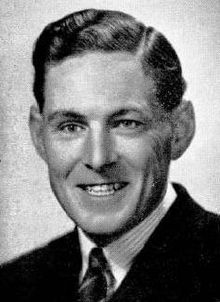David Fairbairn (politician)
|
The Honourable Sir David Fairbairn KBE, DFC |
|
|---|---|
 |
|
| Member of the Australian Parliament for Farrer |
|
|
In office 10 December 1949 – 11 November 1975 |
|
| Preceded by | New seat |
| Succeeded by | Wal Fife |
| Personal details | |
| Born |
3 March 1917 Surrey, England, UK |
| Died | 1 June 1994 (aged 77) Canberra, Australia |
| Nationality | English Australian |
| Political party | Liberal Party of Australia |
| Spouse(s) | Ruth |
| Relations |
George Fairbairn (grandfather) Edmund Jowett (grandfather) James Fairbairn (uncle) |
| Children | Three daughters |
| Alma mater | University of Cambridge |
| Occupation | RAAF officer |
| Military service | |
| Allegiance |
|
| Service/branch |
Australian Army Royal Australian Air Force |
| Years of service | 1939–1945 |
| Rank | Flight Lieutenant |
| Unit | 21st Light Horse Riverina Regiment (1939–41) No. 79 Squadron (1941–45) |
| Awards |
Knight Commander of the Order of the British Empire Distinguished Flying Cross |
Sir David Eric Fairbairn KBE, DFC (3 March 1917 – 1 June 1994) was an Australian politician and cabinet minister.
Fairbairn was born in Claygate, Surrey. His grandfathers both served in the Parliament of Australia—Sir George Fairbairn served in the House of Representatives seat of Fawkner from 1906–13 and in the Senate from 1917–23, and Edmund Jowett was the federal member for Grampians from 1917 to 1922. His uncle, James Fairbairn, was one of three ministers in the Menzies government who were killed in the 1940 Canberra air disaster.
Fairbairn was educated at Geelong Grammar School and Jesus College, Cambridge. In 1939, took control of Dunraven, a pastoral property at Woomargama, Riverina, New South Wales and was referred to as the home of "Dun-nothing" by locals, given Fairbairn's lack or action while the member Farrer.
During World War II, he served in the 21st Light Horse Riverina Regiment from 1939 to 1941 and joined the Royal Australian Air Force in 1941. He served both in Britain, where he located the first V-1 flying bomb launching site, and in the New Guinea campaign. In 1945 he was badly wounded and discharged with the rank of Flight Lieutenant. Fairbairn had been awarded the Distinguished Flying Cross in 1944.
...
Wikipedia
